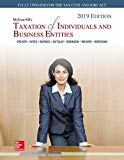
Loose Leaf for McGraw-Hill's Taxation of Individuals and Business Entities 2019 Edition
10th Edition
ISBN: 9781260189728
Author: Brian C. Spilker Professor, Benjamin C. Ayers, John Robinson Professor, Edmund Outslay Professor, Ronald G. Worsham Associate Professor, John A. Barrick Assistant Professor, Connie Weaver
Publisher: McGraw-Hill Education
expand_more
expand_more
format_list_bulleted
Question
Chapter 3, Problem 48P
To determine
Indicate which option you prefer $1,200 today or $1,750 in four years, if Person E earns 10% after tax
Expert Solution & Answer
Want to see the full answer?
Check out a sample textbook solution
Students have asked these similar questions
General accounting
What were free cash flow and earnings for the period of this financial accounting question?
By how much will the contribution margin increase?
Chapter 3 Solutions
Loose Leaf for McGraw-Hill's Taxation of Individuals and Business Entities 2019 Edition
Ch. 3 - 1. The goal of tax planning is to minimize taxes....Ch. 3 - Prob. 2DQCh. 3 - In this chapter we discussed three basic tax...Ch. 3 - What are the two basic timing strategies? What is...Ch. 3 - Prob. 5DQCh. 3 - What are some common examples of the timing...Ch. 3 - What factors increase the benefits of accelerating...Ch. 3 - How do changing tax rates affect the timing...Ch. 3 - Prob. 9DQCh. 3 - Prob. 10DQ
Ch. 3 - Prob. 11DQCh. 3 - What two factors increase the difference between...Ch. 3 - What factors have to be present for income...Ch. 3 - Prob. 14DQCh. 3 - Prob. 15DQCh. 3 - Prob. 16DQCh. 3 - Prob. 17DQCh. 3 - Prob. 18DQCh. 3 - Prob. 19DQCh. 3 - Explain how implicit taxes may limit the benefits...Ch. 3 - Prob. 21DQCh. 3 - Do after-tax rates of return for investments in...Ch. 3 - Prob. 23DQCh. 3 - Prob. 24DQCh. 3 - Prob. 25DQCh. 3 - What is an implicit tax and how does it affect a...Ch. 3 - Several judicial doctrines limit basic tax...Ch. 3 - What is the constructive receipt doctrine? What...Ch. 3 - Prob. 29DQCh. 3 - Relative to arms length transactions, why do...Ch. 3 - Prob. 31DQCh. 3 - Prob. 32DQCh. 3 - Prob. 33DQCh. 3 - Prob. 34DQCh. 3 - Yong recently paid his accountant 10,000 for...Ch. 3 - Billups, a physician and cash-method taxpayer, is...Ch. 3 - Prob. 37PCh. 3 - Prob. 38PCh. 3 - Prob. 39PCh. 3 - Prob. 40PCh. 3 - Prob. 41PCh. 3 - Prob. 42PCh. 3 - Prob. 43PCh. 3 - Prob. 44PCh. 3 - Prob. 45PCh. 3 - Prob. 46PCh. 3 - Prob. 47PCh. 3 - Prob. 48PCh. 3 - Prob. 49PCh. 3 - Prob. 50PCh. 3 - Prob. 51PCh. 3 - Prob. 52PCh. 3 - Prob. 53PCh. 3 - Prob. 54PCh. 3 - Prob. 55PCh. 3 - Prob. 56PCh. 3 - Prob. 57PCh. 3 - Prob. 58PCh. 3 - Prob. 59PCh. 3 - Prob. 60PCh. 3 - Prob. 61PCh. 3 - Prob. 62PCh. 3 - Prob. 63PCh. 3 - Prob. 64PCh. 3 - Prob. 65P
Knowledge Booster
Similar questions
- Refer to the investment opportunity for 2025 (purchase of new machinery) and calculate the following. Where discount factors are required use only the four decimals present value table (Appendix 1). Ignore taxes. 1. Payback Period (expressed in years, months and days). 2. Accounting rate of return on initial investment (expressed to two decimal places). 3. Net Present Value. Your answer must include the calculation of the present value(s) and NPV. 4. Internal Rate of Return (expressed to two decimal places). Your answer must include two net present value calculations (using consecutive rates/percentages) and interpolation. 5. Internal Rate of Return (expressed to two decimal places) if the machine is expected to have a salvage value of R200 000. Your answer must include two net present value calculations (using consecutive rates/percentages) and interpolation.arrow_forwardWhat is the company's stockholders equity?arrow_forwardPlease provide solution this financial accounting questionarrow_forward
- General accounting questionarrow_forwardGeneral Accountingarrow_forwardA company’s fixed monthly expenses are $35,000, and its contribution margin ratio is 62%. Assuming that the fixed monthly expenses do not change, what is the best estimate of the company's net operating income in a month when sales are $110,000? Helparrow_forward
arrow_back_ios
SEE MORE QUESTIONS
arrow_forward_ios
Recommended textbooks for you


